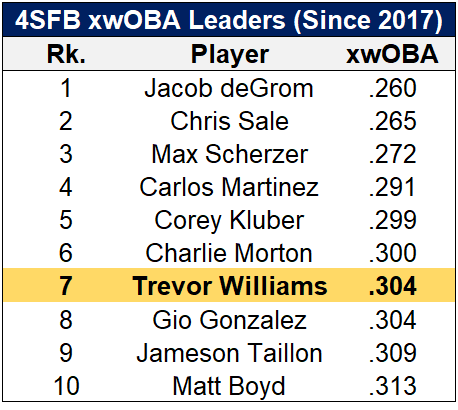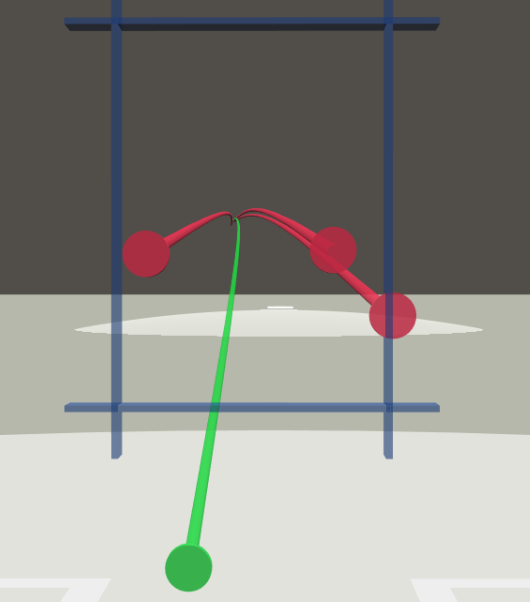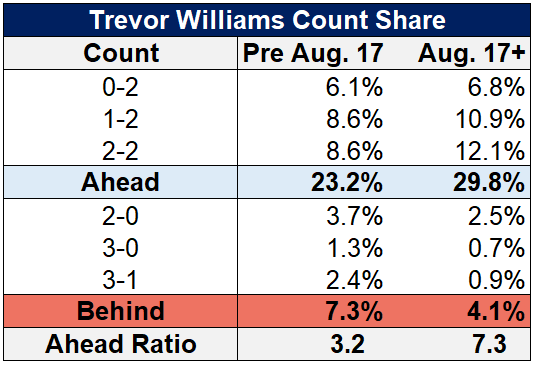The fantasy stock of Pittsburgh Pirates starting pitcher Trevor Williams is a perfect case study in the analytical shift that has occurred across baseball in the last several years. Despite possessing the second-lowest ERA of any starter since the 2018 all-star break, Williams’ current ownership in ESPN fantasy leagues sits at a middling 41%.
In 2019, an era replete with a bevy of advanced statistics, fantasy owners are no longer seduced by Williams’ 1.42 ERA over his last 89 innings. Instead, they focus on a decidedly mediocre 4.18 xFIP and impossible-to-sustain 90% strand rate — peripheral indicators that suggest he will allow more runs to cross the plate in short order.
But there is more than meets the eye with Williams. Armed with an upper-tier four-seam fastball, Williams is adept at inducing soft contact: a skill which will lead to an ERA that consistently outperforms estimators like FIP and xFIP. In addition, since last August, Williams has displayed a newfound ability to induce whiffs, evidenced by a surge in his swinging strike and strikeout rate to above average levels.
The combination of elite contact control with strong whiff inducement is making Williams’ hot streak look more sustainable. While he will certainly regress from his current run prevention levels, Williams’ current skill set should allow for a 3.50 ERA / 1.20 WHIP performance baseline with a significant amount of wins and quality starts thrown in for good measure.
We’ve Lost Contact
The right-handed Williams is a “kitchen-sink” hurler, tossing four different pitches: a four-seam fastball, two-seam fastball, slider, and changeup — each over 15% of the time in 2018. The four-seamer is his most frequently used pitch with a roughly 50% utilization rate. Its 91.8 mph velocity is below average, while its horizontal and vertical movement scores range in the 25th percentile. However, in spite of a seemingly bland profile, Williams’ four-seam fastball has been one of the best in baseball since his MLB debut.
In fact, the pitch is so effective that it ranks as the seventh-best four-seamer in terms of xwOBA among starters since 2017. The pitch achieves these results mainly through suppression of hard contact, as its swing and miss rate of 17% in 2018 was actually below the league average of 20%.
On the back of his fastball, Williams is in the 79th percentile or higher in average exit velocity, exit velocity on fly balls and line drives, expected batting average on contact, and barrel rate. These underlying readings have propelled Williams to an exceptional 0.89 HR/9 and .278 BABIP thus far in his career, which is why his 3.67 ERA trends well below his 4.48 xFIP.
Je Ne Sais Quoi
One might be left wondering how Williams can achieve such outsized results with a plain-looking fastball and an array of secondary pitches that look equally pedestrian.
“Je ne sais quoi” is a French expression that literally translates as “I don’t know what.” However, it is used more generally to describe an undefinable quality that makes something distinctive.
Williams’ fastball, despite below average speed and movement, has a certain “je ne sais quoi” quality to it. After being stymied by Williams in a September 2018 matchup, Brewers infielder Travis Shaw stated that “His fastball’s just hard to square up. I don’t know what it is.”
https://gfycat.com/PowerlessParchedCoypu
Hitters like Shaw have a difficult time picking up on Williams’ fastball for three reasons. First, Williams hides the ball very well prior to release, ensuring that hitters do not get a jump start by reading the pitch selection early. Secondly, he tunnels his pitches effectively, ranking in the upper echelon in PreMaxTime among MLB pitchers (read Mike the Roto Cop’s February post for further insight into this and other tunneling stats). As a result, hitters have to decide very late in the ball’s flight path what type of pitch is coming and whether to swing.
Lastly, and perhaps most importantly, Williams’ fastball features significant late break. That is, despite displaying minimal overall movement, most of the motion in Williams’ fastball occurs after the hitter makes his swing decision. The 3D pitch plot from the Shaw at-bat in the GIF above, with four-seamers identified by red dots and the lone changeup by a green dot, highlights this phenomenon.
Notice the significant late life on Williams’ fastball on both the inner and outer half of the plate, which is likely a significant contributor to the frequent poor contact that hitters derive on these pitches. In 2018 Williams ranked in the 91st percentile in PrePlateRatio, a stat that measures how much of a pitch’s location is determined by movement incurred after the hitter’s decision-making threshold.
The above pitch plot also highlights Williams’ command of the strike zone. Williams is routinely able to move the ball to the edge in any part of the zone. Baseball Savant defines the edge of the strike zone as the shadow of the plate. Since 2017, 45.1% of Williams’ four-seamers end up in this shadow zone, which ranks 12th out of 149 qualified starters.
By combining tight pitch tunnels, late movement, and excellent command, Williams keeps hitters off balance. Perhaps his fastball success isn’t so ambiguous after all.
The Next Step
While plenty of pitchers have crafted MLB careers based on deception and poor contact, that’s an approach that is becoming increasingly difficult to sustain in a modern day MLB packed with juiced balls and home runs. Pitchers need to able to control their own destiny via whiffs and strikeouts if they want to craft long-term, sustainable success.
Williams’ career 8.3% swinging strike rate and 18.1% strikeout rate are both well below average figures that would make long run prevention difficult. But buried in the midst of Williams’ 2018 strand-rate-fueled streak was a subtle adjustment in approach that is leading to some very meaningful underlying gains.
Through 59 2/3 innings since an August 17th start against the Cubs, Williams’s ability to induce swinging strikes, along with swings on pitches outside the strike zone, has surged. The combination of these factors has led to an increase in strikeout rate from 16.0% prior to August 17th to 22.8% since. His sparkly 1.81 ERA in that span is backed by a 2.80 FIP and 3.69 xFIP — estimators more indicative of sustainability.
What prompted this change? A combination of a more aggressive early-count approach and improved control allowed Williams to pitch ahead more often. Prior to August 17th, two-strike counts accounted for 23.2% of Williams’ pitches, a figure which jumped to 29.8% thereafter. Concurrently, Williams pitch share in 2-0, 3-0, and 3-1 counts declined from 7.3% to 4.1%.
The net effect of these changes resulted in Williams more than doubling his ratio of pitching ahead. The benefits of pitching ahead are numerous, with the pitcher nearly twice as likely to induce a swing on a pitch outside the strike zone with two strikes compared to other counts. Whiff rates also go up considerably when the pitcher is ahead.
Williams did not change his overall pitch mix to achieve these results. However, all of his pitches benefited. In particular, the swinging strike rate on his slider increased from 11.3% to 17.4%. A lack of strong secondary pitches is one of the reasons that many remain skeptical of Williams. However, a slider that maintains those swing and miss levels, along with its already impressive exit velocity suppression, suffices as a plus secondary offering.
Concluding Thoughts
The fantasy baseball community is understandably skeptical of Williams’ miraculous 15-start run since last July. However, they shouldn’t let his sky-high strand rate distract them from the significant improvements he made in the process. Given his already elite exit velocity management, Williams profiles as an upper-echelon starter if he can maintain a strikeout rate in the low-20% range and a swinging strike rate hovering around 12.0%.
While he won’t ever rack up 200 strikeouts in a season, Williams is a safe bet to provide 15 wins and 20 quality starts, along with decent ERA and WHIP ratios, if the improvements made in his last 10 starts stick.
Photo by Justin Berl/Icon Sportswire






The only part I disagree with is him being a safe bet for 15 wins because the Pirates offense is pretty awful. If deGrom isn’t a safe bet for 15 wins, Williams surely isn’t.
Outside that, great work Nick!
Thanks, Dave! That’s a fair point regarding wins – 15 might be more of the high watermark than the expectation.
I think you are greatly overselling an analytical shift. Owners are passing on Williams because of his lacking K rate – not because of his low ERA. All of those advanced estimators are feeding off of that low and decreasing K rate. I think he will have a hard time winning 15 games on that Pirates team as well. We live in a reality where the Cy Young awards were given to the guy who led in Wins and the ERA leader last year. I am not sure that things have changed a whole lot over the past decade and they certainly haven’t changed in the past few years. Your analysis of Williams is great but you could skip the progressive narrative. I would appreciate it at least.
Thanks for your comments! The lack of Ks is definitely a central reason that people fade Williams. But in an era increasingly bereft of Wins and Quality Starts, I would think fantasy owners should see the value in having a pitcher that’s been a lock for six innings and three or less earned runs. Clearly, there was a big element of them not trusting his run prevention.
I’d assume the reason that ownership in fantasy leagues (and overall faith in his peripherals + results) sits at such a low level is partially due to the universal panning he has received from every online and print publication. This is the first positive take I’ve read on Trevor Williams, and the ONLY article I’ve seen that doesn’t just dismiss his repertoire as trash (followed by the the inevitable “it’s pure luck, it’s unsustainable, take your chances at your own risk, it’ll end in tears, it’s a total fluke” etc etc etc). THANK YOU for actually explaining WHY his fastball works, and HOW he is limiting hard contact, instead of just sneering and calling him a fringe average 5th starter TOBY (and for not implying that his success is down to a Faustian bargain and an emery board).
Hi, I think this is a great article. I’m pretty new to fantasy baseball, and I sadly just dropped Trevor Williams but not because I think he’s a bad pitcher– I actually think he’s a phenomenal pitcher. Maddux was my favorite pitcher growing up and Williams reminds me of that. I had to drop him because, like other commenters said, in a category league, he only consistently helps with era/whip ratios because his strikeout and win rates aren’t great. I’m sad that so many people bash him and it seems like they’re relying too heavily on the assumption that our current level of analytics/statistics maps perfectly onto skill/quality of player.
There is also this article that is one of the few other positive articles about Trevor that I could find, and it’s super interesting as well.In any case, thanks a bunch for taking the time to do this. Great write-up.
http://www.thepointofpittsburgh.com/the-quality-start-the-maddux-and-now-the-williams/